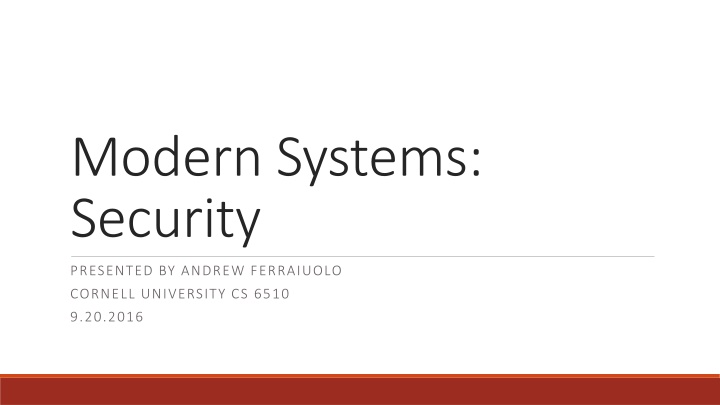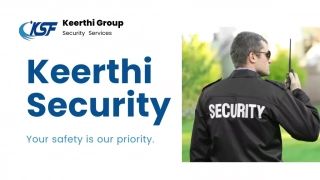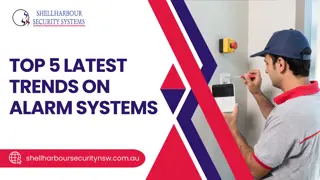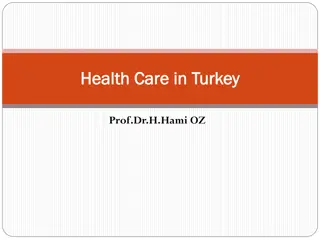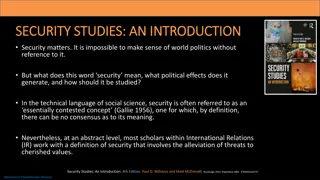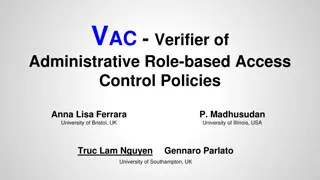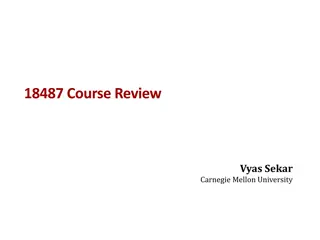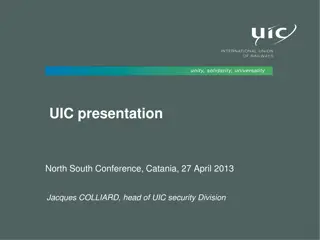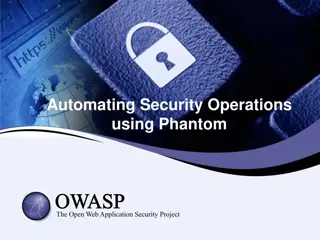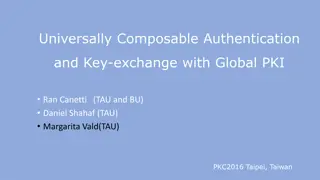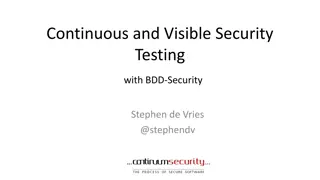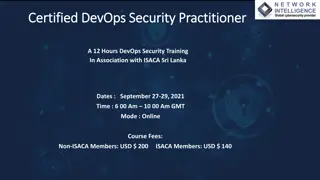Modern Systems Security Overview
In this content, various topics related to modern systems security are discussed, such as secure systems approaches, information flow tracking, hardware authentication, trust bases, and credentials-based authorization. It covers concepts like fabric, hardware root-of-trust, confidentiality, integrity, operating systems applications, and more. The content delves into the importance of information flow analysis and trust models in enhancing security measures for systems.
Download Presentation

Please find below an Image/Link to download the presentation.
The content on the website is provided AS IS for your information and personal use only. It may not be sold, licensed, or shared on other websites without obtaining consent from the author.If you encounter any issues during the download, it is possible that the publisher has removed the file from their server.
You are allowed to download the files provided on this website for personal or commercial use, subject to the condition that they are used lawfully. All files are the property of their respective owners.
The content on the website is provided AS IS for your information and personal use only. It may not be sold, licensed, or shared on other websites without obtaining consent from the author.
E N D
Presentation Transcript
Modern Systems: Security PRESENTED BY ANDREW FERRAIUOLO CORNELL UNIVERSITY CS 6510 9.20.2016
Two Secure Systems Approaches Fabric (Myers) Information flow Nexus (Sirer & Schneider) Credentials-based authentication Hardware root-of-trust
Information Flow Track and constrain the propagation of data throughout the system Confidential Trusted Untrusted Trusted Public Confidential
Information Flow Background Lattice Model (Denning 1976) secret untrusted public trusted Confidentiality and integrity are duals (Biba 1977) Noninterference (Goguen 1982) If an attacker can observe data in set L but not H, execution looks deterministic regardless of H.
Applications of Information Flow Operating Systems DStar, HiStar (Zeldovich 2008) Digital logic Gate-level information flow tracking (Tiwari 2009) Hardware architecture Dynamic information flow tracking (Suh 2003) Type Systems A lot of work (Survey: Sabelfield 2003)
Hardware Authentication: TPM Hardware support for providing remote attestation of software Problems: Cannot describe state-dependent trust Compromises privacy Provides purely axiomatic trust
Trust Bases Axiomatic A principal is assumed to be trusted Trusted platform module Synthetic Transforms untrusted code into trustworthy code Reference monitors, sandboxing Analytic Predicts whether certain program behaviors are possible Proof-carrying code (Necula 1996), information flow!
Credentials Based Authorization Permit access when a principal satisfies some property (Appel 1999) Goal Formula: conditions under which resource can be accessed Credentials: a proof that satisfies a goal formula Nexus adds features to support all three bases of trust. Can Nexus be used to perform information flow analysis? Would you want it to?
Fabric Goal: Secure distributed computation Approach: Secure language information flow type system enforces noninterference Decentralized security multiple distrusting parties, no central authority
Principals Represent entities (e.g., users, groups, nodes) and privileges. Acts-for relation: supports delegation, can be used for access control
Labels Express policies in the code labels are associated with data describe which principals can act on them and how Policies are enforced mostly statically at compile-time Some checks, e.g. for remote procedure calls are checked dynamically
Labels Decentralized label model (Myers 2000) Written in terms of principals Confidentiality { alice bob} Integrity { alice bob } Flow ordering permitted flow among labels Trust ordering restrictiveness of policy (new in this paper)
System Architecture Fabric nodes take one of three forms Storage nodes persistent objects Worker nodes perform computation Dissemination nodes data replication A single host can have multiple nodes
Evaluation: CMS 2X-4X slowdown compared to regular Java
Evaluation: OO7 Benchmark The regular Java implementation is 10X faster
Nexus Goal: Support authorization with all three trust bases. Approach: Nexus authorization logic (NAL) describes principals and their beliefs Reference monitor general-purpose proof-checker enforces NAL OS and hardware features for each basis of trust.
Nexus & Trust Bases Axiomatic trusted platform module supports attested storage /w Merkle trees Analytic Introspection exposes view of kernel state e.g. process lookup tables, IPC ports, application state Synthetic Interpositioning reference monitor can respond to untrusted I/O
Nexus Authorization Logic NAL formulas have form P says S (see Schneider 2009) Principal P believes S to be true Predicates have application-defined meanings Delegation A speaksfor B means that if A says S then B says S. Examples: Typechecker says isTypeSafe(PGM) Server says NTP speaksfor Server on TimeNow
Caching and State Decision cache - caches authorization decisions by the guard Guard cache caches partial proof-checking results. State and Authorities stateful predicates cannot be cached! Authorities listens on bound IPC, answers queries about stateful predicates.
Comparison of Approaches Information flow Credentials based authentication Comprehensive/transitive Noninterfere-ish (declassification) Confidentiality/integrity, not availability Constrains at resource interface Policies Written by OS writer General propositional logic Policies Written by app developer Trust relationships TCB: OS(25k), theorem-prover, crypto TCB: compiler(33k), crypto
Questions Overall, which approach do you prefer? Do you see any value in using both? What is a reasonable (performance) cost for security in practice? Is it 10%? 10X? 100X? What do you think should be the root-of-trust? The hardware? OS? Compiler? Theorem-provers?
Perspective Noninterference is powerful, but too restrictive Practical systems rely on declassification/endorsement. No single answer. (Survey paper: Sabelfield 2009) Need to address covert channels to be truly comprehensive. Is formal verification the answer? seL4
